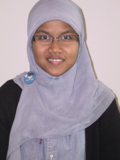 In this thesis the focus was on achieving optical control over functional proteins. ‘This was done by connecting them to artificial molecular switches,’ Rindia Putri says. ‘We choose light because we can control it well, both in time and on different length scales. Above that light is relatively non-destructive towards protein systems.’
In this thesis the focus was on achieving optical control over functional proteins. ‘This was done by connecting them to artificial molecular switches,’ Rindia Putri says. ‘We choose light because we can control it well, both in time and on different length scales. Above that light is relatively non-destructive towards protein systems.’
The switches pave the way to effectively interfere with current protein mechanisms, such as allosteric communication or hierarchical self-assembly. ‘We not only learn more in understanding cooperative or collective effects in living matter,’ Rindia stresses. ‘We now may hope to work on a new class of smart bio-hybrids.’
Three types of proteins were addressed in this thesis work. In the first ‘marriage’ of photoswitch and protein, monomeric human serum albumin was involved.
In the next chapters of this thesis also proteins forming cages (the encapsulins) all the way to chaperone proteins (known to assist cellular protein folding) were involved. ‘At all scales spiropyran derivatives were used as photo-switches,’ thus Rindia. ‘Their irradiation may induce a change in conformation. It also yields a zwitterionic (dipolar) form. This can be bound, to influence a protein environment, be it temporarily or permanently.’
In her thesis work, among others, Rindia showed ligand binding to a protein can be modulated by irradiation with light.
Further, by modification of a bacterial encapsulin, local modifications were yielded, not comprising the structural integrity and behaviour of the assembly as a whole. ‘Bacterial encapsulins proved robust while labelled with light-switchable fluorophores,’ she says. ‘This make them good candidates as smart nanoplatforms for future in vitro and in vivo research purposes.’
Photo-responsive hybrids
Mediation by a spiroyran-based photoacid may also lead to an assembly of transient superstructures that depend on light irradiation, to prevent disassembly. ‘This represents a dynamic and reversible order by a continuous input of energy,’ Rindia explains.
‘Overall, in my thesis work photo-responsive protein-based hybrids with dynamic regulations were developed. Via incorporation of photo-switches, optical control has been demonstrated across various length scales: from several nanometers up to tens or hundreds of nanometers, and from monomeric structures to highly defined multimeric architectures made of proteins.’
BNT Group
The presented research provides a means to interfere with dynamic regulations of proteins, and it supports strategies towards the development of biocompatible and smart materials.
‘Optical switches were worked on for several years already in our Biomolecular Nanotechnology Group,’ Rindia says. ‘The marriage between photoswitches and proteins, I was the first one to explore in our group. A vast part of the work was designed beforehand, and we expected to succeed in fabrication and experimental results, for example the light-controlled ligand binding part. Using the switches to build up the 200 nanometer scaled light-fueled superstructures though, went far beyond our expectations.’
Mesa+ Day
The major part of her work was experimental in nature. ‘At the yearly Mesa+ meeting, I was happy to meet Professor Claudia Filippi of the CCP (Computational Chemical Physics) Group,’ she says.
‘She got interested in my work by watching my poster presentation. From there, we started to collaborate on the theoretical part, especially involving ligand binding and release processes. In simulations we checked our experiments, helping us to explain the results and also learning from there to build new clever experiments. The collaboration proved very fruitful indeed, covering a vast part of my thesis work.’
Indonesia
After her PhD Defense, Rindia will return to Indonesia from which she received the LPDP Indonesia Endowment Fund for Education.
Rindia: ‘First I will join an already existing Group, in which I hope to introduce the new knowledge and techniques I have learnt here at Mesa+. Later in my career it is my ambition to start independent lines of research, or even a Group of my own, thus contributing to the scientific progress in my home country.’
